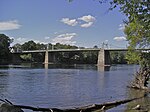Volendam Windmill
Agricultural buildings and structures in New JerseyBuildings and structures in Hunterdon County, New JerseyDutch-American culture in New JerseyFlour mills in the United StatesGrinding mills in New Jersey ... and 6 more
Holland Township, New JerseyNew Jersey building and structure stubsOctagonal buildings in the United StatesPower station stubsSmock mills in the United StatesWind power in New Jersey

Volendam Windmill is a smock mill located on Adamic Hill Road in Holland Township, New Jersey, United States. The windmill was designed and built in 1965 by Paul and May Jorgenson, using windmills they had seen in Denmark and The Netherlands as models. The Volendam Windmill Museum is a working mill driven by wind, used for grinding raw grain into flour. The 60-foot structure is seven stories high with sail arms 68 feet from tip to tip. In 2007, two of the sail arms of the windmill were damaged in a windstorm. As of 2021, the county's website shows that the museum is closed.
Excerpt from the Wikipedia article Volendam Windmill (License: CC BY-SA 3.0, Authors, Images).Volendam Windmill
Adamic Hill Road,
Geographical coordinates (GPS) Address Nearby Places Show on map
Geographical coordinates (GPS)
| Latitude | Longitude |
|---|---|
| N 40.5966 ° | E -75.1639 ° |
Address
Adamic Hill Road
08848
New Jersey, United States
Open on Google Maps









